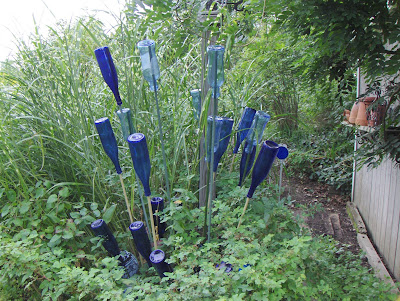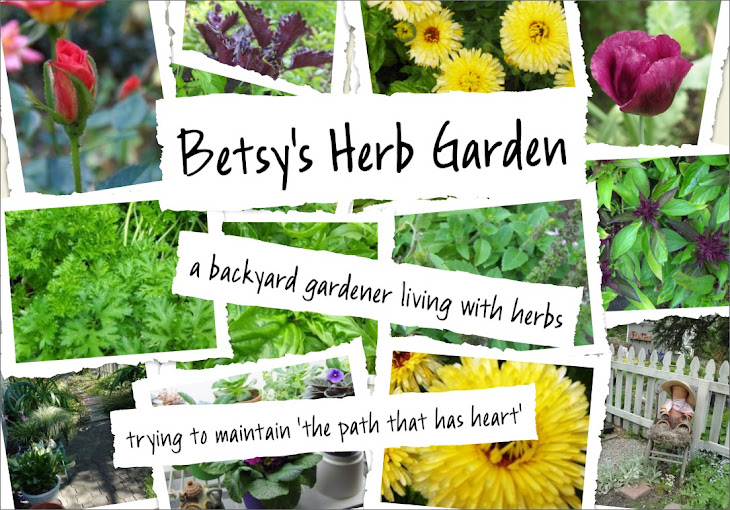I've been composting my yard and kitchen organic refuse for thirty something years now. I get misty just thinking about it.
Our small 50's suburban backyard was shaped into the then-desired uniform flatness by the landscraper bulldozing our topsoil into the cow pasture behind the property line, leaving a cold damp greyish pottery clay for us to raise our vegetables in.
When we bought the house in the 70's, we spent the first years digging and removing 20 year old junipers so hugely overgrown that the boys used them as 'forts', and plug ugly shrub honeysuckle hedges, and weak-wooded Norway maples that shaded the whole damp lot and a badly placed spruce tree that is now a nice front yard accent in my neighbor's yard.
My early flower beds and borders were double dug (by me), and the later ones were done by the 'lasagna' method. I lasagna'd before it was cool - it was just easier on my back and it just made sense.
And in the backyard, on that clay where the honeysuckle hedge once malingered, Herb built a raised bed veggie garden. With dirt hauled in from local dirt sellers, who dumped piles in the driveway that we wheelbarrowed one bleedin' wheelbarrow at a time back to the garden, and bales of then okay Canadian peat, and great piles of leaves from the 150 year old oak and the remaining maples, and all that compost over all those years.
Herb grows delicious tomatoes and peppers.

We have two compost "piles". One in each back corner of the veggie garden. A few fence posts and some wire fencing is all you really need. Mine are mostly screened by shrubbery (a couple of remaining honeysuckles) and on the other side, a large clump of ornamental grass. (I also have a black plastic donated composter thingie artistically anchoring one of my flower beds.)
Can you see the compost pile? back behind the zebra grass (a Miscanthus)?

We compost using the "cold' method. Cold compost has lots of nutrition and good humus left in it. A pile on a tarp is a pile of brown gold.
You've been made to think that cold compost has weeds. Don't worry about weeds. If you refrain from throwing the seed heads of noxious weeds in your pile you shouldn't have a problem with weeds. Weeds are a part of life, you know. Not just philosophically, but the web of life, I mean. What is it that herbalists often say, "A weed is simply a plant whose use has not been discovered (or valued) yet"?
Dammit, I wish I could remember where I learned this little interesting thing so I could provide a link, but did you know that the soil is full of such a diversity of life at the microbe level that scientists have not identified it all yet - they are just beginning the process. Dr. Beirnbaum at MSU says that right there in a handful of soil are more living beings than all the population of humans on earth. Doesn't make you want to put any chemicals on it, does it. A teaspoon of Monsanto's latest petrochemical whizbang might just be a tiny unseen nuclear bomb to that handful of billions of microbes.
As I understand it there seems to be three basic levels of life in the soil. We're all familiar with the creatures we can see - the macro level of life, so to speak... burrowing mammals, toads, worms, various larvae and so on. Then there is the middle level of soil life, fungal mats and strings, nematodes, and stuff like that that you can see with a regular microscope. But what many people don't seem to know is that there is a microbe level of life that supports all of the bigger things. And we are learning more and more that the health of the macro - us and "our" plants and animals - is dependent on the health of the very smallest but most diverse and numerous part of the whole system.
That web of life, that is what the word 'ecology' means.
For healthy soil, you need mineral, that comes from the original rock that the earth was. And you need living organisms, the three levels of life, with emphasis on the smallest, like the foundation of a building. And finally you need food for the microbes. The carbonaceous living matter that recycles endlessly through eons that makes what we so lightly dismiss as dirt, and abuse with bad practice, and depend upon for our future.
As certified Master Composter Phil Downs said at the compost talk he gave to the Master Gardeners last Thursday, honoring our soil with good practice is doing our part "for the next seven generations," (a quote many times attributed to the Native American chief Seattle, but whoever said it first it was a wise and agreeable thing to say.) Just as an aside, my friend Phil also says, at times, in Latin, something about not letting the 'so and so's' grind us down, which I really like.
I'm finally wending my way to the the very interesting thing (that I'm trying to recall the source for but can't, sorry) which is that the roots of plants, including weeds, secrete some chemical that draws or beckons microbes, and then supports their tiny invisible life in the area of the root zone of the plants. So life begets life in symbiosis, at the root zone.
When will those at the top of the food chain learn to support the roots as the roots have always supported them? Oh no, now I'm getting political that's for the cranky blog. But as the end point of all this morning's pondering: I'm wondering if the concept of living mulch to shade the soil and supress weeds and to support microbial life will begin to take hold as more gardeners learn of this?

7 comments:
I love the cobalt blue bottles! One of my very favorite colors to decorate the garden with. You make a lot of sense about the compost. Just don't know if my poor back can take what your's has! I need to do what you're doing, though. Thanks for the info.
Brenda
Thanks for the comment, Brenda! The blue bottles are about the only vivid color in my garden right about this time of year, barring the occasional cardinal.
Cold composting doesn't take so much work, that's why we do it!
I wonder if I could count garden blogging as Master Gardener volunteer hours? LOL as they used to say...
That was an interesting post ... I've been a composter for a long time and am about to get my first bin of worms on Sunday.
Smudging with worms sounds like fun ... mine will reside in the basement where they should be okay.
Betsy, this is SUCH a terrific post. Intelligent, informative, and a flash or two of humour, too! (I love your friend Phil's Latin quote too, and use it regularly, usually in referring to government, of course.) I too am inspired by the cobalt blue bottles and think I'll try something like that in part of our garden. Thank you for the inspiration!
Greetings from another passionate Michigan herb lover. A pleasure visiting your site, Betsy ;) I shall return ...
I'm truly enjoying the design and layout of your website.
It's a very easy on the eyes which makes it much
more pleasant for me to come here and visit more often. Did you hire out a designer to create your
theme? Excellent work!
Appreciating the time and energy you put into your website and in depth infodmation you offer.
It's giod to comne across a blog every once iin a while
tha isn't the same out of date rehashed information. Great read!
I've bookmarked your site and I'm including your RSS feeds to my Google account.
Post a Comment